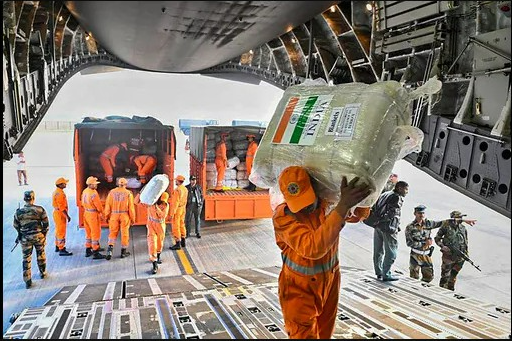Disaster Diplomacy: How India became the World’s First Responder
Human welfare has always been a top priority for the Modi government, regardless of where a crisis unfolds — even if it involves a non-ally. This approach reflects his proactive, inclusive, and globally engaged leadership, embodying India’s age-old ethos of Vasudhaiva Kutumbakam— the world is one family.
Total Views |
Ayam bandhurayam neti ganana laghuchetasam |
Udaracharitanam tu vasudhaiva kutumbakam ||
(The narrow-minded people think this way,
“Here’s my friend and there’s my enemy.”
The noble-hearted ones among us say,
“All the world is my own family.”)
India’s soft power is often associated with yoga, Bollywood, and cultural elements like cuisine and spirituality. However, its role in humanitarian aid and disaster relief (HADR) has been equally significant in shaping its global image. Through swift and effective responses to natural and man-made crises, India has reinforced its strategic ties while demonstrating a deep commitment to global solidarity. Rooted in the philosophy of Vasudhaiva Kutumbakam, the world is one family, India has positioned itself as a first responder in HADR. The recent Operation Brahma, launched to assist Myanmar after a devastating earthquake, is another example of India's role as a responsible and compassionate global power. PM Narendra Modi has also offered help to Thailand after the same natural calamity.

The ten-year period from 2014 to 2024 has witnessed numerous humanitarian crises. The crises were triggered by, among other things, armed conflicts (Israel-Hamas war, Russia-Ukraine war, etc), the COVID-19 pandemic, and natural disasters. In the face of these challenges, India stepped up its HADR efforts that are aimed at saving lives, alleviating suffering, and maintaining and protecting human dignity during and in the aftermath of emergencies. In doing so, India has positioned itself as a first responder in HADR, especially to the Global South. This is a significant milestone because the country has long been a recipient. But, in the past decade, the roles have reversed, with India emerging as a key provider of humanitarian assistance
Modi government’s approach to HADR efforts
Human welfare has always been a top priority for the Modi government, regardless of where a crisis unfolds — even if it involves a non-ally. This approach reflects his proactive, inclusive, and globally engaged leadership, embodying India’s age-old ethos of Vasudhaiva Kutumbakam— the world is one family. This principle extends beyond manava dharma (human duty) to actively promote global peace and security.
Under his leadership, disaster management has been institutionalised with a comprehensive, whole-of-government approach, ensuring swift response, regional cooperation, and resilience-building. His administration has placed strong emphasis on risk mitigation and preparedness, introducing structured frameworks like the 10-Point Agenda on Disaster Management. This agenda focuses on integration, risk coverage, women's leadership, risk mapping technology, research, media, capacity building, learning and international cooperation
The Indian Armed Forces (Army, Navy, Air Force, and Rapid Action Forces) have played a crucial role in India’s disaster response, showcasing India’s capability in global humanitarian missions. Regular joint exercises with regional and global partners reinforce its role as a first responder in crises. Initiatives like Operation Chakravat, introduced by PM Modi in 2015, and Tiger Triumph, a US-India bilateral tri-services exercise, Sanyukt Vimochan, demonstrate India's dedication to enhancing operational preparedness and interoperability. The Annual Joint HADR Exercise, conducted alternately by the Army, Navy, and Air Force, has seen participation from multiple Indian Ocean Region nations, fostering collaboration on disaster response strategies. By consistently engaging in these drills, India is reinforcing regional cooperation, strategic diplomacy, and military readiness, ensuring a swift and effective response to future humanitarian crises.
India’s Global Rescue Missions
According to new data released by MyGov India, Indian authorities have rescued nearly 10,000 Indians imprisoned abroad since 2014.
This development comes after 500 Indians were pardoned in Dubai ahead of Ramzan, bringing the total number of Indian prisoners freed from the UAE to 2,783 since 2014.
The diplomatic efforts of the Modi government and PM Modi's strong global ties have played a crucial role in securing the release of Indians imprisoned abroad. A major success was the release of eight former Indian Naval officers from a Qatari prison, where they had been on death row and later faced long sentences. Arrested in August 2022 and sentenced to death in October 2023 on espionage charges, their fate seemed uncertain. However, through assertive diplomacy, legal strategy, and PM Modi’s direct intervention, they were pardoned by the Emir of Qatar, marking a significant triumph for Indian diplomacy and its global influence.
2025 - Over 500 Indians have been pardoned from serving sentences by the UAE ahead of Ramzan this year.
2024 - India's diplomatic intervention secured the release of 8 Navy veterans sentenced in Qatar.
2024-23 - Iran freed 77 Indian nationals in 2024 and 43 Indians, including 12 fishermen in 2023, showcasing strong Indian diplomacy
2019 - Saudi Crown Prince Mohammed bin Salman ordered the release of 850 Indian prisoners during his visit to India.
2019 - During PM Modi's visit, Bahrain freed 250 Indians who were in jail as a goodwill gesture.
2017 - Kuwait's Emir freed 22 Indian prisoners and reduced sentences for 97 others after diplomatic talks.
Sri Lanka has repeatedly released Indian fishermen after diplomatic engagements. Since 2014, 3,697 Indian fishermen have been freed through these efforts
Source: Vayuveg
.
.
.
.
.
.


